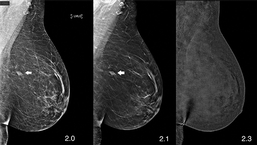In the U.S., more than 1 million breast biopsies are performed annually, yet less than 25 percent of these biopsies yield a diagnosis of breast cancer.

Zuley
One reason for this low predictive value is that most lesions categorized as needing biopsy are of relatively low suspicion. These include lesions classified as 4A, where probability of malignancy ranges from >2 to <10 percent, or 4B, where probability of malignancy ranges from >10 to <50 percent under the Breast Imaging Reporting Data System (BIRADS).
Speaking at a Sunday session, Margarita Zuley, MD, a radiologist at the University of Pittsburgh Medical Center, said anatomic characterization of lesions using non-enhanced methods such as mammography, tomosynthesis (3D mammography) and ultrasound (US) are insufficient to significantly improve the positive predictive value (PPV) of a biopsy. On the other hand, contrast-enhanced digital mammography (CEDM) has been shown to have a high negative predictive value for classifying indeterminate mammographic or US findings as benign when no enhancement is seen.
In her study, Dr. Zuley investigated whether CEDM used during diagnostic evaluation could increase biopsy PPV for soft tissue density lesions by reducing benign biopsies while not impacting the biopsy rate of cancers. Patients were prospectively enrolled into an International Review Board-approved trial that included a research CEDM study immediately prior to biopsy of their 4A or 4B imaging-identified lesions.
"Our study looked at mammography, tomosynthesis or US identified lesions that were masses, asymmetrie s or areas of distortion with or without calcifications," Dr. Zuley said.
Researchers then performed a reader study that included eight radiologists reviewing 60 cases three times, rating each using the BIRADS scale. Initially, readers rated the mammogram and tomosynthesis only, then re-rated the case after adding US.
The team then re-rated the case again with the addition of CEDM. Looking at the performance of each rating, Dr. Zuley noted that CEDM significantly improved appropriate use criteria (AUC) over the performance of mammogram, tomosynthesis and US.
Although larger studies are needed to validate this trial, Dr. Zuley said the potential impact of these results for patients – not to mention the economic considerations – is significant because the majority of biopsies in the U.S. are performed for lesions classified as 4A and 4B.
"Contrast-enhanced digital mammography may be an important new tool for eliminating unneeded biopsies of some actually benign breast lesions without having a significant impact on sensitivity," Dr. Zuley said. "If validated, this paradigm could alter the benefit/risk ratio of screening mammography."

LMLO 2D (image 2.0) and 3D (image 2.1) demonstrate an indeterminate focal asymmetry rated as BIRADS 4A (white arrows). LMLO CEDM (image 2.3) demonstrates no enhancement in the area of concern. Biopsy revealed a benign concordant result.

